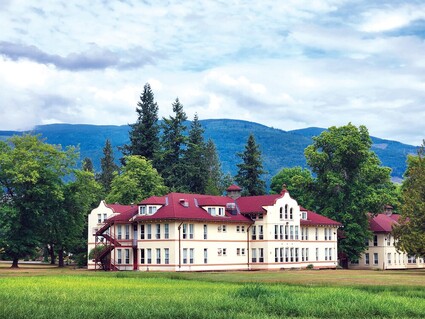Keeping history alive at Northern State Hospital
August 9, 2023

Adam M. Sowards
SPANISH REVIVAL - Most of the buildings on the Northern State Hospital campus feature Spanish Revival architecture. Some buildings, such as this one, have been maintained. Many other buildings have sustained vandalism and weather damage since the facility closed in 1973.
To keep history alive, it must be tended like a garden. On Saturday, July 29, community members gathered at Northern State Hospital in Sedro-Woolley to nurture memories of family members of patients and staff. About 300 people came to Public History Day at the grounds to share artifacts and stories and learn from experts about the hospital, which closed 50 years ago.
"Personal stories are the most powerful," said Sharon Howe, the research librarian at the Sedro-Woolley Museum, one of the sponsors of the event.
So Public History Day's purpose was to collect materials and memories for local historical museums and to be a venue for stories.
Several years ago, the museum staff at both the Skagit Valley Historical Museum and the Sedro-Woolley Museum realized that their collections did not include many Northern State materials, despite public interest and inquiries. Jo Wolfe, the director of the Skagit County Historical Museum, another sponsor, realized, they needed "to find a way to capture that information so we can share it."
Last year, the first Public History Day was "a great success," said Wolfe.
Volunteers recorded oral histories from those willing to share. In the last two years, about 30 new oral histories have been recorded.
Donated artifacts, as well as scanned photos and letters, will also be added to museum archives. Some of the artifacts given included a patient-made end table and a woven rug. Someone shared their great-grandfather's pocket notebook that included a list of tools used to clear the land, a process that began in 1910.
These historical materials become seeds for understanding the varied meanings of this landmark.
Northern State Hospital "was just a human place," said Amy Muia, a writer and Northern State researcher who served as the day's master of ceremonies. "It was a place where flawed human beings cared for other flawed human beings with the knowledge that they had at the time."
For 60 years, Northern State treated mental illness with various therapies, pharmaceuticals and procedures, including lobotomies and sterilizations.
One of the day's speakers, John Horne, is an expert on all things Northern State, especially the cemetery. "The cemetery is a huge passion of mine, because at the time people were kind of disposed of back then," said Horne.
When he started investigating the cemetery, Horne found two dozen visible grave markers. Since then, he has located about 600 and made 205 visible. "I feel like that even if there's just a chunk of concrete that's all that's left of someone's life is a number and initials, [we] should at least be able to see it," he said.
A team of journalists from the Seattle Times recently produced a series of stories, including a documentary, about Northern State that has helped revive interest. They shared how they worked and noted how timely its story is, given current crises in mental health care.
Carrie Davidson, who, along with Horne, was featured in the Times' project, joined them. Her great-grandmother spent almost a decade at Northern State and died there. Davidson's quest to find family helped her feel connected, but she knows she will continue to search. Materials gathered at Public History Day may help someone like Davidson in the future.
Saturday's event started with overcast skies, but as speakers shared, the sun appeared. The chairs remained full all day with dozens standing nearby and wandering the beautiful grounds, peeking through broken windows to see inside the historic buildings.
Representatives from The Port of Skagit, the final sponsor, shared updates about potential developments of the property it owns. Protecting the historical significance is a priority, and not just the old Spanish Colonial Revival buildings.
"Some of the stories are sad, some of them are inspiring," said Linda Tyler, communications director for the port. Events like this are special because, "we get to capture those stories from folks before we lose them."

Public History Day affirmed the significance of Northern State to Skagit County history and demonstrated how many people are eager to cultivate its memory.
The Sedro-Woolley Museum contains a permanent exhibit of Northern State Hospital. The Skagit County Historical Museum currently has a temporary exhibit on the hospital that will remain up until October after which there will be a portion as part of their permanent displays.

Adam M. Sowards
"A HUMAN PLACE" - Dozens of people came to the Northern State Hospital campus in Sedro-Woolley to learn the history of the hospital and its treatment of patients between 1910 and 1973.
Sowards retired as a history professor at the University of Idaho in 2022. He is a freelance writer for Skagitonians to Preserve Farmland. His stories have appeared in Smithsonian Magazine and the Everett Herald.





Reader Comments(0)